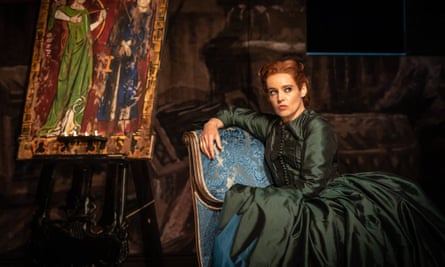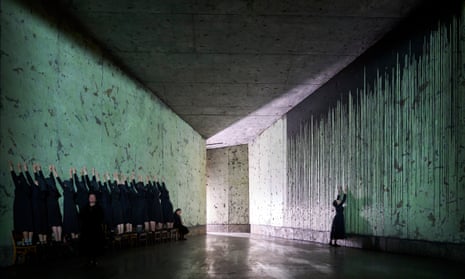An opera with the compulsive power of Poulenc’s Dialogues des Carmélites (1957) all but stumps rational response. Barrie Kosky’s new production of Carmélites for Glyndebourne – after his runaway success in 2015 with Handel’s Saul – is riven with discontinuity: extraneous shouts and sighs, slow fades to black, awkward silences between the many short scenes. At the same time the impact – with incisive conducting by Robin Ticciati, Glyndebourne’s music director, flawless playing by the London Philharmonic Orchestra and an accomplished cast – disturbs and confounds. That the two responses can coexist, vexation with eulogy, is part of the unspoken contract you enter into with this most audacious of directors.
Everything in the work is specific, even the date: 17 July 1794, when 16 Carmelite nuns from Compiègne in northern France were executed by guillotine, at the height of French revolutionary terror. The libretto is based on a later, fictionalised account. Poulenc’s music, with its Ave Maria and Salve Regina, is steeped in the Catholic liturgy he refused or infused all his life. For Kosky, a Jewish atheist (his own words), the opera’s wider relevance had to be unlocked. If you were feeling disputatious, you could say that the point of any masterpiece is its resonance beyond literal limits. But the Australian director is fertile with ideas, and he is not shy to hammer them home.
First the music: with a star lineup that included Karen Cargill as a sympathetic Mother Marie, voice resonant with meaning and gradation, and Golda Schultz, golden-toned and alive as Madame Lidoine, the ensemble of nuns was sharply characterised. Katarina Dalayman, as the dying prioress Madame de Croissy, showed us mortality at its worst, physical and spiritual pain vying for dominance. Florie Valiquette, as the vivacious young Sister Constance, was an ideal foil for Sally Matthews, formidable physically and vocally in the main role of Blanche de la Force, debilitated by fear but in the end brave. The fleeting male roles, led by Vincent Ordonneau as the priest, have little chance to impress, but were mainly well taken. Ticciati kept the score’s gauzy, delicate textures in balance, the LPO’s solo woodwind, and the many small groups of instruments Poulenc favoured, interweaving in constant and haunting dialogue.

The bare space, a fixed set throughout, has intimations of Daniel Libeskind’s Jewish Museum in Berlin: textured “concrete” walls pincering to a strip light at the rear. A Holocaust echo underlines that impression in the opera’s closing moments. The nuns wear modern-ish, below-knee habits and ugly sandals that look almost fashionable. Playing with time, the men – father and brother of Blanche – wear frock coats and breeches: the old guard. Katrin Lea Tag’s designs, with lighting by Alessandro Carletti (using shadow to bold effect), keep the stage empty. Tables and prayer kneelers are brought in and out as needed. Walls ooze blood. A luscious garden arrives, with a slow swish like a rainforest. At the moment of crisis, the nuns’ safe harbour is violated. The horror of attack is any time, any place, now. We are spared nothing. Nor should we be.
Grange Park Opera opened its 2023 season with Wagner’s Tristan und Isolde, the company’s second production, again conducted by Stephen Barlow. The director-designer Charles Edwards has created a precisely observed pre-Raphaelite world, a mix of stuffy Victoriana – dark wood, potted palms, heavy upholstery – and medieval dreams. Each wanton pose echoes the paintings (almost exactly contemporary with Wagner’s 1850s composition) of John Everett Millais or William Holman Hunt, or the red-haired obsession of Dante Gabriel Rossetti: Rachel Nicholls, secure and vocally daring as Isolde (she also sang the role at Longborough), sports a wig of long, auburn abundance.

Even when jumping from console table to sofa or lying on her back, this British Wagnerian never misses musically. At fortissimo – on which Wagner is keen – her tone can flare, but she also has a capacity for soft persuasion. As Tristan, Gwyn Hughes Jones, a Welsh-born tenor with a busy international career, has impressive stamina, top notes true and seemingly effortless. Edwards encourages theatrical gesture but reins in physical passion in Act 2 (small relief given the length of this night of ecstasy).
With Christine Rice as the troubled Brangäne, David Stout a credible and frustrated Kurwenal and Mark Le Brocq creepily distasteful (in character, not voice) as Melot, the supporting cast has no weakness. Above all, Matthew Rose, as King Marke, gave a sterling performance, oppressed by regal sadness and the burden of betrayal, his voice as magnificent and burnished as ever. He is a singer who graces any stage. Barlow’s approach to the score is measured, well shaped – almost to a point of danger in the languid opening prelude but then proceeding with unforced, perceptive momentum. Grange Park Opera’s resident Gascoigne Orchestra, with a focus on lyricism rather than volume, boasted a cor anglais solo to match the best.

At the time of writing his Turangalîla-Symphonie, Olivier Messiaen was enthralled by the Tristan and Isolde myth. That fixation spilled into the profusion of his 1949 mighty work, which Simon Rattle chose for his final programme at the Barbican as music director of the London Symphony Orchestra. The prelude to Messiaen was a world premiere by Betsy Jolas, now 96 and present in the hall. Her Ces belles années…, witty and percussive, nimbly reflected her own near-century and Rattle’s years with the LSO. The players, required to shout and stamp, were joined midway through its jubilant, burbling journey by the soprano Faustine de Monès. Her brief contribution ends with a worthy instruction: “Let’s all sing together, let’s sing for joy.”
Then Rattle and his forces poured every atom of heart, mind and energy into Turangalîla, gongs and cymbals crashing climactically, keyboards (solo pianist Peter Donohoe) manic, ondes martenot (Cynthia Millar) crazed and voluptuous. Vitally, Rattle kept emotion and structure poised. Hear the same forces in Edinburgh on 18 August. Go, yield and swoon.
Star ratings (out of five)
Dialogues des Carmélites ★★★★
Tristan und Isolde ★★★★
LSO/Rattle ★★★★★
Dialogues des Carmélites is at Glyndebourne until 29 July
Tristan und Isolde is at Grange Park Opera until 9 July

Comments (…)
Sign in or create your Guardian account to join the discussion